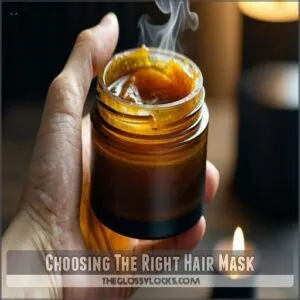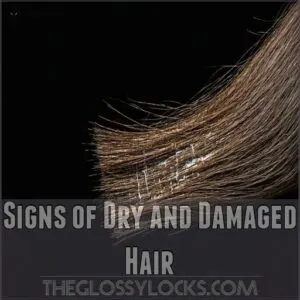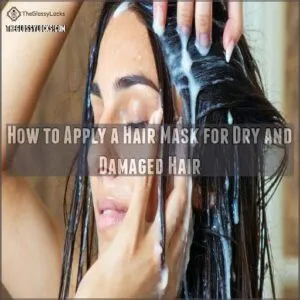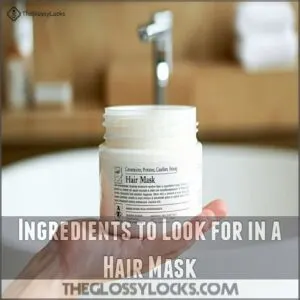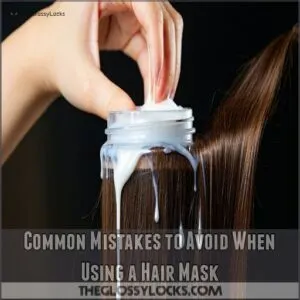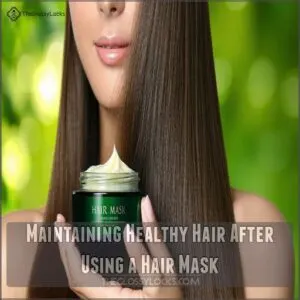This site is supported by our readers. We may earn a commission, at no cost to you, if you purchase through links.

Leading options include K18’s peptide-powered mask for severe damage, SheaMoisture’s bond-repair formula for chemical processing, and OUAI’s lightweight solution for fine strands.
Look for ingredients like keratin, argan oil, and biotin, which work together to restore moisture and strength.
You don’t need to spend a fortune – while some premium masks deliver exceptional results, several budget-friendly options pack similar punch.
The real secret lies in choosing the right formula and applying it correctly for maximum benefits.
Table Of Contents
- Key Takeaways
- Choosing The Right Hair Mask
- Best Hair Masks for Dry and Damaged Hair
- Signs of Dry and Damaged Hair
- How to Apply a Hair Mask for Dry and Damaged Hair
- Ingredients to Look for in a Hair Mask
- Common Mistakes to Avoid When Using a Hair Mask
- Maintaining Healthy Hair After Using a Hair Mask
- Frequently Asked Questions (FAQs)
- What are the best hair masks for dry hair?
- How can you get rid of dry ends in hair?
- Can a hair mask repair dry hair?
- What’s a good hair mask?
- Why do you need a hair mask for dry hair?
- Should you wear a mask if your hair is dry?
- What is the best hair mask for dry, damaged hair?
- What is the best treatment for dry and damaged hair?
- Which hair mask is best for dry hair at home?
- Is it better to put a hair mask on dry hair?
- Can I use a hair mask while swimming?
- How long do hair mask results typically last?
- Should I apply hair mask to scalp or ends?
- Can I mix different hair masks together?
- Will using hair masks make my hair greasy?
- Conclusion
Key Takeaways
- You’ll get the best results by choosing ingredients that match your hair’s needs – look for ceramides and proteins for severe damage, or natural oils and butters for intense moisture.
- K18’s peptide mask excels at repairing bleach and heat damage in just 4 minutes, while SheaMoisture’s Bond Repair works wonders for chemically processed hair with its hydroplex formula.
- You should apply masks to damp hair from mid-lengths to ends, leave them on for the recommended time (usually 5-20 minutes), and use them once or twice weekly for optimal results.
- You’ll need to pair your mask treatments with proper maintenance – get regular trims every 8-10 weeks, use protective styling like silk pillowcases, and avoid heat styling to maintain healthy hair.
Choosing The Right Hair Mask
You’ll find the perfect hair mask for your damaged strands by matching your hair’s specific needs with the right ingredients and formula type.
With options ranging from bond-building treatments to deep moisturizing masks, you can transform your dry, brittle hair into soft, manageable locks that’ll make bad hair days a thing of the past.
What is a Hair Mask?
Think of a hair mask as your hair’s emergency care package.
Unlike regular conditioners, these intensive treatments pack a powerful punch of concentrated ingredients designed to transform your stressed-out strands.
Here’s what sets hair masks apart:
- Deep-penetrating formulas that work below the surface
- Higher concentrations of moisturizing and repairing ingredients
- Longer-lasting results compared to daily conditioners
It’s like sending your hair to a spa day, but from the comfort of your bathroom.
How to Use a Hair Mask
Before diving into your hair mask routine, start with freshly shampooed, towel-dried hair.
Apply the mask generously from mid-lengths to ends, using a wide-tooth comb to make sure even distribution.
You can find a wide variety of damaged hair masks available online at damaged hair mask products.
Many masks work best when left on for 5-20 minutes, but check your product’s instructions.
For deeper penetration, wrap your hair in a warm towel.
Benefits of Using a Hair Mask
Hair masks work wonders, like a superpower for your strands!
They boost hair hydration, banish frizz, and add shine, while repairing and strengthening your hair.
Bringing back life to dry, damaged hair, these masks also promote scalp health.
It’s like treating your hair to a mini spa day, giving it the love and care it truly deserves.
Best Hair Masks for Dry and Damaged Hair
When your hair is screaming for some TLC, the right hair mask can work wonders in bringing it back to life.
We’ve rounded up five effective picks for dry, damaged hair, each promising to nourish and soothe with every application.
1. K18 Hair Mask Repair Damaged Hair
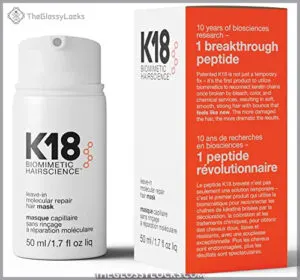
Taming unruly hair feels like herding cats, doesn’t it?
Enter the K18 Hair Mask Repair Damaged Hair—a superhero cream for your strands.
This leave-in treatment whisks damaged locks back to life fast, thanks to its K18Peptide mojo.
Whether it’s color chaos or heat havoc, this gem renews strength and bounce in just four minutes.
Lightweight yet potent, it manages to avoid that greasy aftermath.
While it’s a bit pricey, a little magic goes a long way.
Truly, it’s the knight in shining armor for your tresses!
Best For: Those with bleach-damaged, color-treated, or heat-styled hair who want to restore strength and bounce.
- Repairs damaged hair in just four minutes.
- Leaves hair feeling soft, smooth, and bouncy.
- Contains a patented K18Peptide that renews hair from the inside out.
- Expensive.
- Some users report hair fall, but it could be due to damaged hair shedding.
- May not be necessary for all hair types.
2. SheaMoisture Bond Repair Hair Masque
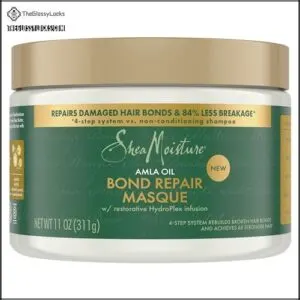
When battling the woes of dry, damaged hair, the SheaMoisture Bond Repair Hair Masque might just be your new best friend.
This creamy concoction promises to nourish and repair hair with its powerful hydroplex infusion, reminiscent of the benefits of using products like Shea Moisture Coconut.
Packed with Amla Oil and Fair Trade Shea Butter, it restores luster and minimizes breakage—making your hair six times stronger.
The masque’s magic works in just five minutes, leaving your hair hydrated and shiny.
It’s like a spa day for your tresses, transforming them with every use.
Best For: This masque is ideal for those with dry, damaged, and processed hair, particularly those with curly or coily hair types.
- Repairs split ends and minimizes breakage.
- Provides intense hydration and shine.
- Contains natural ingredients like Amla Oil and Shea Butter.
- May leave a "coated" feeling after rinsing.
- Some users prefer alternating with deep moisture treatments.
- Requires a longer wait time compared to some other hair masks.
3. SachaJuan Overnight Hair Repair
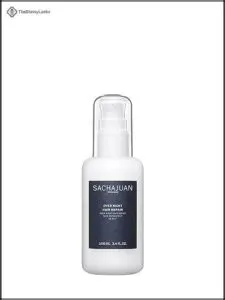
A luxurious option, SachaJuan’s Overnight Hair Repair is a gel-based treatment.
It’s packed with sea algae, delivering proteins and minerals to revive damaged hair.
Think of it as a nighttime spa treatment for your locks.
You apply it to wet or dry hair, leaving it in overnight.
While some find the scent strong, many appreciate its softening effect.
Results? Healthier, stronger strands by morning.
Just remember, it’s a splurge; however, a little goes a long way.
One bottle could easily last you eight months.
Best For: This is best for those with damaged hair looking for a luxurious overnight treatment.
- Replenishes hair with proteins and minerals
- Provides overnight repairing and reinforcing action
- Can be used as a leave-in conditioner
- Some users report a drying effect on hair
- Some users report no noticeable difference in hair condition
- The product is relatively expensive
4. Overnight Hair Repair Mask
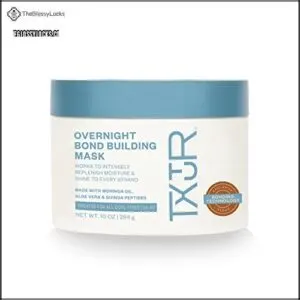
Ever wake up with hair that looks like you stuck a finger in a socket?
An Overnight Hair Repair Mask might just be your night-time hero.
Designed to soak into your curls while you dream, this mask boosts shine, softness, and manageability.
However, it can get a bit messy, so try a soft towel on your pillow.
Ingredients like Moringa Oil and Quinoa Peptides dive deep, but beware—fine or frizz-prone hair might feel greasy.
Still, it’s worth a bedtime experiment for healthier locks!
Best For: Those with curly hair seeking deep moisture and manageability.
- Contains vegan hair bonding technology for enhanced moisture.
- Moringa Oil and Quinoa Peptides help detangle and improve shine.
- Pleasant and lingering fragrance.
- Can leave hair feeling greasy.
- May not be suitable for fine or wavy hair.
- Can be messy and uncomfortable to use overnight.
5. OUAI Fine to Medium Hair Mask
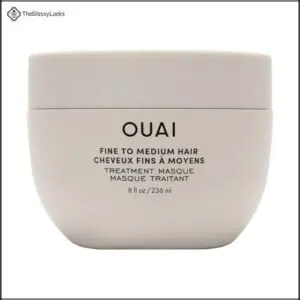
For those tackling dry and frizzy hair, the OUAI Fine to Medium Hair Mask could be your new best friend.
Packed with nourishing ingredients like shea butter and hydrolyzed keratin, this rich treatment smooths, hydrates, and strengthens strands, taming even the unruly.
Though some might find its scent a bit strong, others appreciate the sophisticated aroma.
It’s not the cheapest option, and the jar can be tricky to open, but the silky, shiny results might just make it worth your effort.
Best For: Those with fine to medium hair who struggle with dryness, frizz, and split ends.
- Smooths, hydrates, and strengthens hair.
- Improves curl definition and adds shine.
- Leaves hair feeling silky without greasiness.
- Strong scent may be overwhelming for some.
- Expensive compared to other brands.
- Jar may be difficult to open.
Signs of Dry and Damaged Hair
When your hair looks as lively as a wilted houseplant, it might be trying to tell you it’s dry and damaged.
Watch out for signs like dullness, brittle strands, split ends, and a lack of that glossy shine, all indicating it’s time for some hair TLC.
Dull and Brittle Hair
Spotting dull and brittle hair often feels like dealing with a deflated balloon—lifeless and tough to style.
Your hair lacks energy, resisting all your styling efforts and refusing to hold any bounce.
This struggle signals it’s time to rethink your hair routine.
Introducing a hydrating hair mask can revive those locks, restoring luster and vitality over time.
Split Ends and Breakage
Split ends and breakage are major red flags for dry, damaged hair.
You’ve tried everything, yet your hair still looks like it’s been through a battlefield.
To combat dryness and breakage, consider incorporating a hair mask for dry hair into your routine, which you can find at a hair mask marketplace.
Here’s how to combat it:
- Use a deep conditioning hair mask for split ends weekly.
- Trim your hair regularly to prevent further damage.
- Avoid heat styling by opting for gentle, natural methods.
Frizz and Unmanageability
When your hair rebels against every styling attempt, frizz and unmanageability are clear signs of damage.
Your strands might feel like they’ve got a mind of their own, especially in humid weather.
This resistance often means your hair’s protective layer is compromised, making it more susceptible to environmental factors.
If you’re using more styling products than usual just to keep your hair in check, it’s time to address the underlying damage.
Lack of Shine and Luster
A healthy head of hair naturally catches and reflects light, but damaged strands just won’t sparkle like they used to.
While frizzy hair can be tamed, lack of shine often signals deeper damage.
Your hair’s natural oils can’t travel down the hair shaft when it’s damaged, leaving you with dull, lackluster locks.
Think of it like a broken mirror – when the surface isn’t smooth, it can’t reflect light properly.
How to Apply a Hair Mask for Dry and Damaged Hair
You’ll be amazed at how a proper hair mask application can transform your dry, damaged strands into silky-smooth locks that’ll make you feel like you’ve just stepped out of a salon.
Whether you’re new to hair masks or you’re looking to perfect your technique, we’ll show you the exact steps to get the most out of your treatment and achieve those head-turning results you’ve been dreaming of.
Pre-Treatment Preparation
Now that you’ve identified those telltale signs of damage, let’s get your hair ready for some serious TLC.
Start by hopping in the shower and using a clarifying shampoo to remove any product buildup.
Your hair type will determine how thoroughly you should towel dry – fine hair needs less moisture, while thick or coarse strands can handle a gentler squeeze-dry approach.
Mask Application and Distribution
Getting your hair mask application right is like painting a masterpiece – it’s all in the technique.
Start by dividing damp hair into 4-6 manageable sections.
Apply the mask starting from mid-lengths to ends, using your fingers to work it through each section.
For thick or coarse hair, use a wide-tooth comb to make sure even distribution and prevent product buildup in specific areas.
Leave-in Time and Rinsing
Your properly applied hair mask needs time to work its magic.
Most masks require 5-15 minutes, but some, like K18, work in just 4 minutes.
Keep an eye on the clock – leaving it on too long won’t boost results.
Once time’s up, rinse thoroughly with lukewarm water until the water runs clear.
You’ll know you’re done when your hair feels smooth but not slick.
Post-Treatment Care and Maintenance
After rinsing out the hair mask, gently squeeze excess water with a microfiber towel to prevent breakage.
Skip your regular conditioner—your hair’s already well-nourished from the mask.
Style as usual, but dial back on heat tools for the next day to maximize the mask’s benefits.
Lock in the treatment’s goodness by using a leave-in conditioner and avoiding tight hairstyles that could stress your freshly treated strands.
Ingredients to Look for in a Hair Mask
You’ll want to get familiar with key ingredients like ceramides, proteins, and natural oils that can transform your dry, damaged strands into healthier hair.
While the ingredient list on hair masks might look like a chemistry exam, knowing which powerhouse ingredients to look for will help you choose the perfect mask for your hair’s needs.
Moisturizing Ingredients
When battling dry, damaged hair, the right moisturizing ingredients can transform your locks from straw-like to silky.
Here are four powerhouse hydrators you’ll find in the best hair masks:
- Hyaluronic acid draws moisture from the air, holding up to 1,000 times its weight in water
- Glycerin helps maintain moisture balance
- Natural oils like argan and jojoba mimic your hair’s natural oils
- Plant butters like shea and cocoa create a protective moisture barrier
Protein-Based Ingredients
Protein-based ingredients work like tiny building blocks to repair and strengthen damaged strands.
Look for hydrolyzed keratin, wheat protein, or silk amino acids in your hair mask – they’ll help patch up those weak spots and prevent future breakage.
But don’t go overboard! Too much protein can make hair stiff and brittle.
Balance is key, so aim to use protein-rich masks every other week.
Nourishing Oils and Butters
Natural oils and butters work wonders for restoring moisture to dry, damaged hair.
You’ll find ingredients like argan oil, which penetrates deep into the hair shaft, and shea butter, known for its intense moisturizing properties.
Look for coconut oil to reduce protein loss, and jojoba oil to balance your scalp’s natural oils.
Mango butter adds slip and shine, while avocado oil’s healthy fats nourish each strand from root to tip.
Antioxidants and Plant Extracts
Looking beyond basic moisturizers, antioxidants and plant extracts work like tiny superheroes for your hair, fighting off damage from environmental stressors.
These natural powerhouses protect and restore your strands from the inside out.
For instance, coconut oil, a common ingredient in many effective DIY hair growth masks, can also be used to nourish and moisturize dry hair.
- Green tea extract blocks harmful UV rays and boosts scalp circulation
- Ginseng root stimulates follicles for faster growth
- Aloe vera soothes scalp irritation and reduces inflammation
- Rosemary leaf extract promotes thickness and shine
- Grape seed extract prevents premature aging and brittleness
Common Mistakes to Avoid When Using a Hair Mask
You’ll be surprised how many people accidentally sabotage their hair mask results with simple mistakes that are easy to fix.
Whether you’re new to hair masks or you’ve been using them for years, knowing what not to do can make the difference between gorgeous, healthy hair and wasted product.
Overusing or Underusing a Hair Mask
Balance is key in hair mask treatments.
While you might be tempted to use masks daily for quick results, overuse can lead to protein overload, making your hair brittle and stiff.
For best repair, consider shopping for a damaged hair mask product that suits your hair type, such as those found on damaged hair mask.
On the flip side, using masks too infrequently won’t give you the repair benefits your damaged strands need.
For most hair types, aim to use a mask once or twice a week for best results.
Not Following Instructions
Reading those tiny instructions on your hair mask isn’t just busywork – it’s your roadmap to healthier hair.
Skipping steps like proper timing or application methods can leave you with less-than-stellar results.
You might be tempted to wing it, but each mask has specific requirements for a reason.
Whether it’s pre-shampooing or leaving it on for the right duration, following the directions makes all the difference.
Using The Wrong Type of Hair Mask
Not every hair mask is your perfect match.
Just like choosing the right shampoo, you’ll need a mask that suits your specific hair type and concerns.
Using a protein-rich mask on already-protein-saturated hair can lead to brittleness, while moisture-heavy masks might weigh down fine strands.
Check the label carefully – your hair’s needs should align with the mask’s ingredients and intended benefits.
Maintaining Healthy Hair After Using a Hair Mask
You’ll need more than just a hair mask to keep those locks looking their best, so let’s explore some essential maintenance tips that’ll help your hair stay healthy between treatments.
While a hair mask can work wonders for your damaged strands, combining it with regular trims and protective styling will give you the gorgeous, healthy hair you’ve been dreaming of.
Regular Trims and Touch-Ups
Regular trims are your hair’s best friend, even when you’re using masks religiously.
To maintain healthy hair, you need to understand the process of a trim, which typically removes about 1/4 to 1/2 inch of hair, depending on the length, thickness, and damage to the hair – learn more about how much hair is cut off in a trim.
Schedule cuts every 8-10 weeks to prevent split ends from traveling up your strands.
If you’re trying to grow out your hair, don’t skip these appointments – getting micro-trims (1/4 inch or less) helps maintain healthy ends while allowing length retention.
Your stylist can also spot early signs of damage and recommend targeted treatments.
Protective Styling and Accessories
You’ve done the work with your hair mask – now let’s keep those results going strong with some smart protection strategies.
Your hair deserves the royal treatment between masks, and here’s how to give it:
- Switch to silk or satin pillowcases to prevent friction and moisture loss while you sleep
- Use gentle hair ties and avoid tight styles that can stress your strands
- Shield your hair with protective wraps or bonnets during workouts and outdoor activities
Regular Hair Masks and Treatments
Maintaining a consistent hair mask schedule helps lock in the benefits of your treatments.
For best results, apply a deep conditioning mask once or twice weekly, depending on your hair’s damage level.
Between salon treatments, try DIY hair masks with natural ingredients like avocado or honey.
Think of these regular treatments as your hair’s "nutrition plan" – they’ll keep those strands strong, healthy, and resilient long-term.
Frequently Asked Questions (FAQs)
What are the best hair masks for dry hair?
For dry hair, try Olaplex No. 8 Bond Intense Moisture Mask or Amika Hydro Rush.
Both deliver deep hydration and repair damaged strands, leaving your hair silky smooth.
They’re worth the investment.
How can you get rid of dry ends in hair?
Holy moly, those split ends are history!
Trim your hair every 8 weeks.
Apply leave-in conditioner.
Use silk pillowcases.
Limit heat styling.
Deep condition weekly with protein-rich masks to restore moisture balance.
Can a hair mask repair dry hair?
Yes, hair masks can effectively repair dry hair by penetrating deep into strands to restore moisture and rebuild damaged bonds.
You’ll notice softer, more manageable hair with regular use of quality masks.
What’s a good hair mask?
K18 Leave-In Molecular Repair Hair Mask is your best bet for quick results in just 4 minutes. It’s lightweight, absorbs fast, and repairs damage without residue. Bonus: You’ll find it’s TikTok-approved.
Why do you need a hair mask for dry hair?
Think of your hair like a thirsty plant – it needs deep hydration to thrive.
Hair mask penetrates deeper than regular conditioner, restoring moisture and repairing damage that’s making your strands brittle and lifeless.
Should you wear a mask if your hair is dry?
Treating dry hair with a mask is essential – it’s like giving your thirsty strands a drink of water.
You’ll want to use one weekly to restore moisture, prevent breakage, and keep your hair healthy.
What is the best hair mask for dry, damaged hair?
Olaplex No. 8 Bond Intense Moisture Mask will transform your damaged strands with its patented bond-building technology.
You’ll love how it rebuilds broken bonds and deeply hydrates while staying lightweight for all hair types.
What is the best treatment for dry and damaged hair?
Discover deep, transformative relief with K18’s Leave-In Molecular Repair Hair Mask.
You’ll love how it repairs damage and restores moisture in just 4 minutes,
making your locks lusciously soft and manageable again.
Which hair mask is best for dry hair at home?
For amazing results at home, try Olaplex No. 8 Bond Intense Moisture Mask.
It’s clinically proven to repair damage, strengthen strands, and boost hydration.
Apply it weekly on damp hair for 10 minutes.
Is it better to put a hair mask on dry hair?
Better safe than sorry – you’ll want to apply hair masks to damp, not dry hair.
The moisture helps the mask’s ingredients penetrate deeper into your strands, making them more effective at nourishing and repairing.
Can I use a hair mask while swimming?
Yes, you can apply a hair mask before swimming!
The chlorine-proof barrier will protect your strands from pool chemicals.
Just wet your hair first, apply the mask, and secure it with a swim cap.
How long do hair mask results typically last?
Hair mask results can work miracles on your locks for 2-3 weeks, depending on your hair care routine.
Benefits will fade faster if you wash frequently or use heat styling tools regularly.
Should I apply hair mask to scalp or ends?
Focus on applying the mask from mid-shaft to ends, avoiding the scalp unless specifically directed by the product.
Target the driest, most damaged sections.
You’ll get better results and prevent buildup.
Can I mix different hair masks together?
Mixing hair masks isn’t recommended since each formula is carefully balanced with specific ingredients.
You’ll get better results using one mask at a time that’s designed for your hair’s unique needs.
Will using hair masks make my hair greasy?
Ever wonder about greasy aftermath?
Greasiness is caused by using too much product or improper application.
You won’t get oily hair if you apply masks correctly from mid-length to ends, avoiding the scalp.
Conclusion
Like a garden needs nurturing, your hair deserves the right care to flourish.
Finding the best hair mask for dry and damaged hair isn’t just about following trends – it’s about understanding your hair’s unique needs.
Whether you choose K18’s peptide power or SheaMoisture’s bond repair, remember that consistency is key.
By making hair masks part of your regular routine and following proper application techniques, you’ll transform your damaged strands into healthy, vibrant locks.
- https://www.instagram.com/mikelstyled/
- https://allure.com/story/best-antioxidant-serums
- http://www.cucinellostudio.com/
- https://www.mdcsnyc.com/provider/brendan-camp-md
- https://nordstrom.sjv.io/c/75786/1960196/23920?subId1=marieclaireus-us-1009016995642776930&sharedId=marieclaireus-us&u=https%3A%2F%2Fwww.nordstrom.com%2Fs%2Ffoundation-reparative-hair-mask%2F7930439%3F

